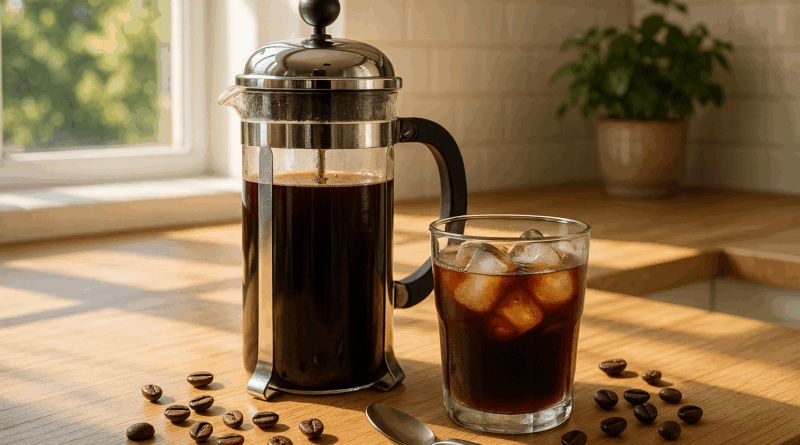How to Make Cold Brew Coffee with a French Press: Easy Step-by-Step Guide
Cold brew shouldn’t be complicated. If you’ve got a French press at home, you already have everything you need to make a smooth, refreshing batch of cold brew coffee—no fancy gear or barista badge required.
Making cold brew in a French press is one of those little tricks that feel surprisingly satisfying: it’s simple, budget-friendly, and the results can rival what you get at your favorite café. Whether you’re prepping a week’s worth of chilled coffee or just looking for a weekend treat, this guide will walk you through the process without overloading you with theory.
Why the French Press Works So Well for Cold Brew
A French press (also known as a cafetière or press pot) is actually a great vessel for cold brewing. Its built-in metal filter makes the final step easy, and the thick glass or stainless steel body helps keep the temperature steady throughout the steeping time. No extra paper filters, no single-use parts—just simple, effective brewing.
Compared to jars or bowls, the French press is also easier to pour from, and it’s made specifically for separating liquid from coffee grounds. That means less mess and more control over your final cup.
The result? A coffee that’s naturally sweet, low in acidity, and easy on the stomach. It tastes smooth and mellow, with none of the harsh bite you sometimes get from hot-brewed methods. It’s the kind of drink that feels indulgent but is almost too easy to make once you know how.
What You’ll Need Before You Start
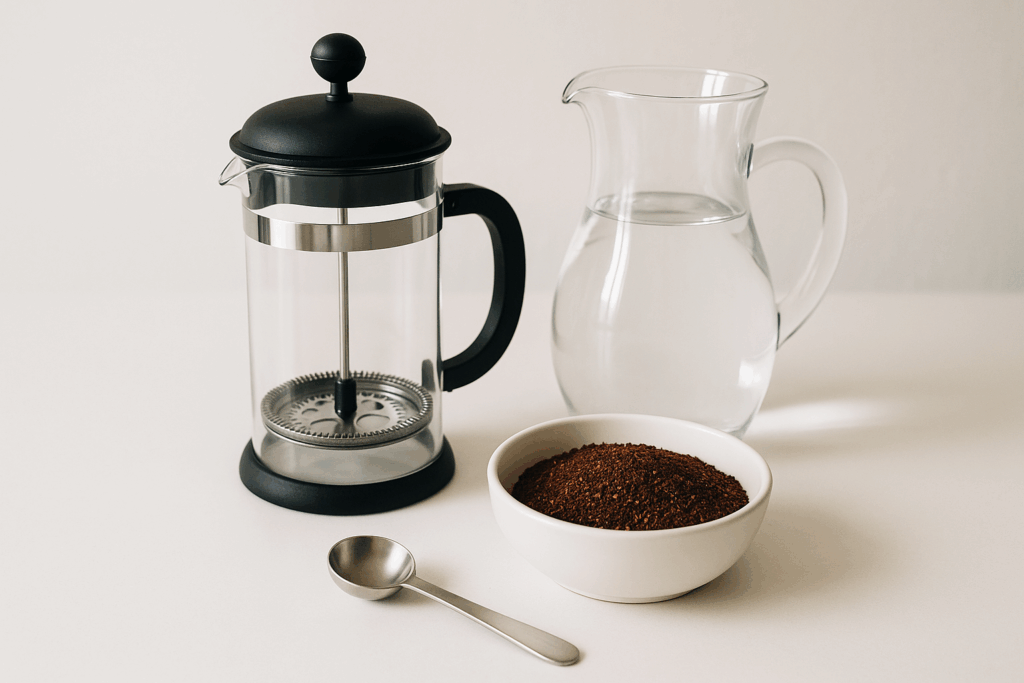
You probably have most of these at home already:
French press – any size will work, but a 1-liter press is ideal for about 2–3 servings
Coarsely ground coffee – think chunky, like sea salt. Finer grinds can lead to bitterness and a gritty texture
Filtered water – ideally at room temperature
A spoon – for stirring
Patience – this part’s underrated, but cold brew needs time to shine.
No special filters, scales, or timers required—but we’ll include tips if you want to level things up.
Your Step-by-Step Cold Brew Routine
1. Add coffee to your French press.
Use a ratio of about 1:8 – that’s roughly 1 cup of coarsely ground coffee to 4 cups of water. It doesn’t need to be exact; this balance gives you a strong, smooth brew that you can always adjust to taste.
2. Pour in the water slowly.
Make sure all the grounds get wet. Pour a bit at first, stir to saturate everything, then add the rest. This helps avoid dry pockets that mess with the flavor.
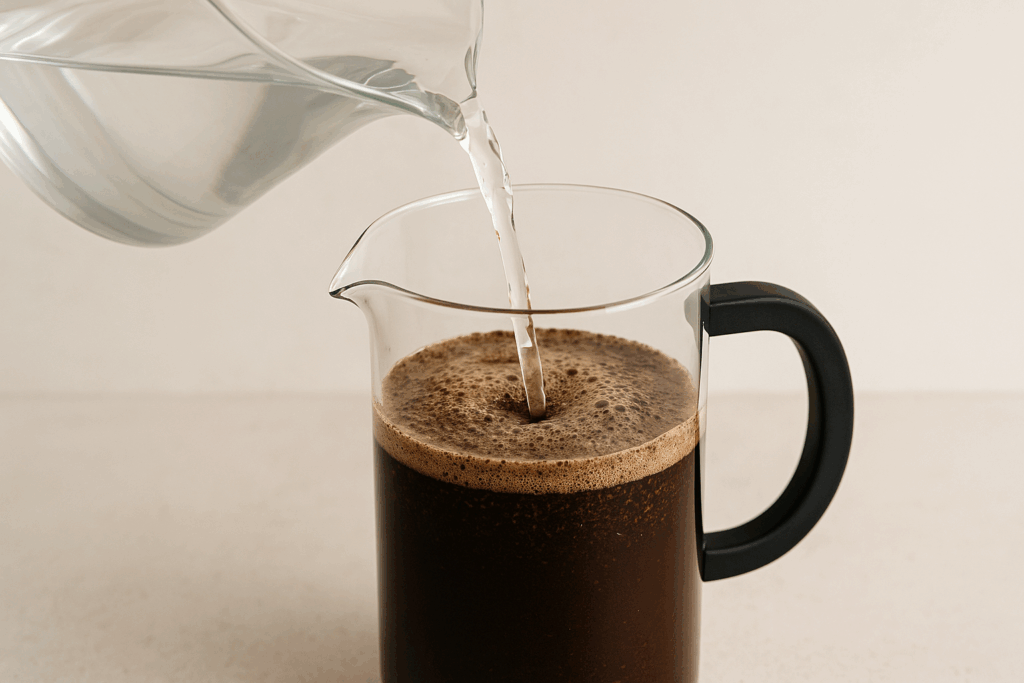
3. Stir gently.
One good stir with a spoon or chopstick is enough. Don’t overdo it—just make sure all the coffee is soaking.
4. Put the lid on—but don’t press.
Let the plunger rest on top to keep dust out, but don’t press it down yet—you want the grounds to float and extract slowly.
Leave your coffee to steep for 12 to 18 hours.
You can let it brew on the counter if the room is cool, or in the fridge for a more consistent, clean result.
5. When time’s up, it’s time to press—gently. Lower the plunger with steady, even pressure. If you feel resistance from the grounds, slow down and don’t force it. You’re aiming for a clean separation, not stirring things back up. Stop just above the bottom if needed to avoid pulling up extra sediment.
6. Pour and enjoy—or store it.
You can drink it straight away or transfer it to a clean jar for later. The cold brew will stay good in the fridge for up to a week. Just give it a swirl before serving.
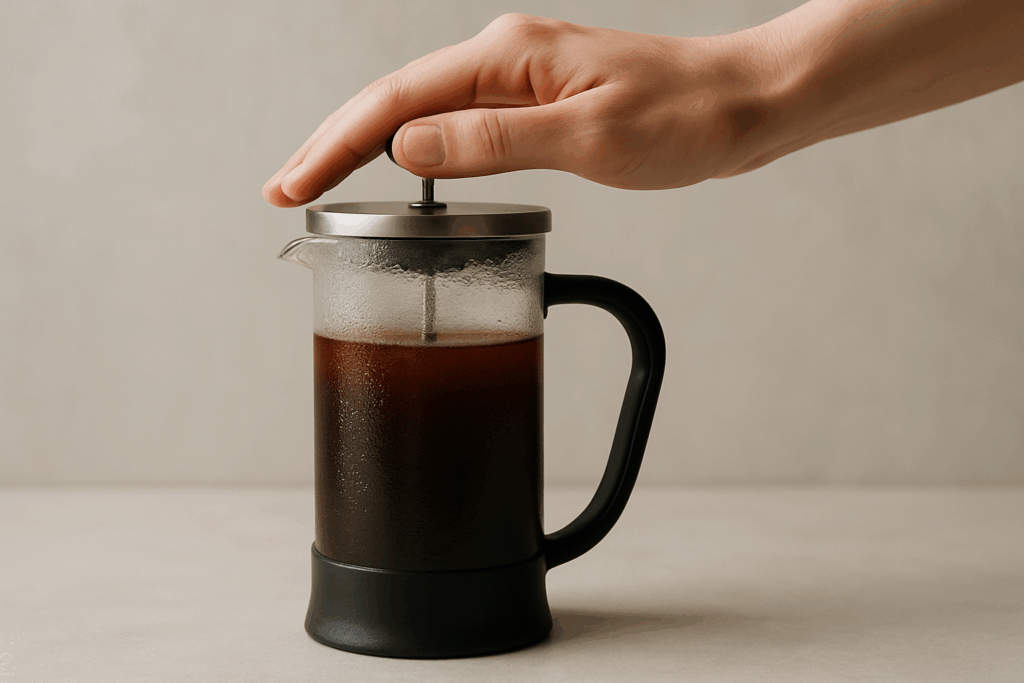
Want an extra-smooth finish? You can pour the coffee through a paper filter or a fine sieve. It’s optional—but if you’re picky about texture, it makes a difference.
Tips for Better Flavor
Cold brew works just as well with decaf beans, too. If you’re curious how decaf coffee is made and what it means for flavor, check out our guide: Decaf Coffee Explained: How It’s Made and How It Affects Flavor Profiles.
One of the great things about cold brew is that it’s easygoing—even if your measurements or timing aren’t perfect, it still turns out delicious. But a few small tweaks can make it even better.
Use freshly ground beans if you can.
Pre-ground coffee will do in a pinch, but for the best flavor, grind your beans right before brewing. A coarse grind helps avoid bitterness and makes the press easier to plunge.
Don’t over-steep.
More time doesn’t always mean better coffee. After 18 hours, your brew may start to taste a bit muddy or overly earthy. If you like a cleaner profile, stick to the 12–14 hour range and adjust based on taste.
Taste before you make changes.
Cold brew is naturally smooth, but different beans bring different personalities. Fruity single origins tend to shine in cold brew, while darker roasts can give you a richer, chocolatey cup. Try a few types—you might be surprised by what you like cold vs. hot.
If it’s too strong, just add water.
Even without making concentrate, your cold brew can pack more flavor than expected. If your first sip feels a bit bold, dilute it with a splash of cold water, milk, or plant-based alternatives until it hits your sweet spot.
How to Store and Serve It Like a Pro
Once brewed, your cold coffee can stay fresh in the fridge for up to a week—just store it in a sealed jar or bottle. A glass jar with a lid works perfectly.
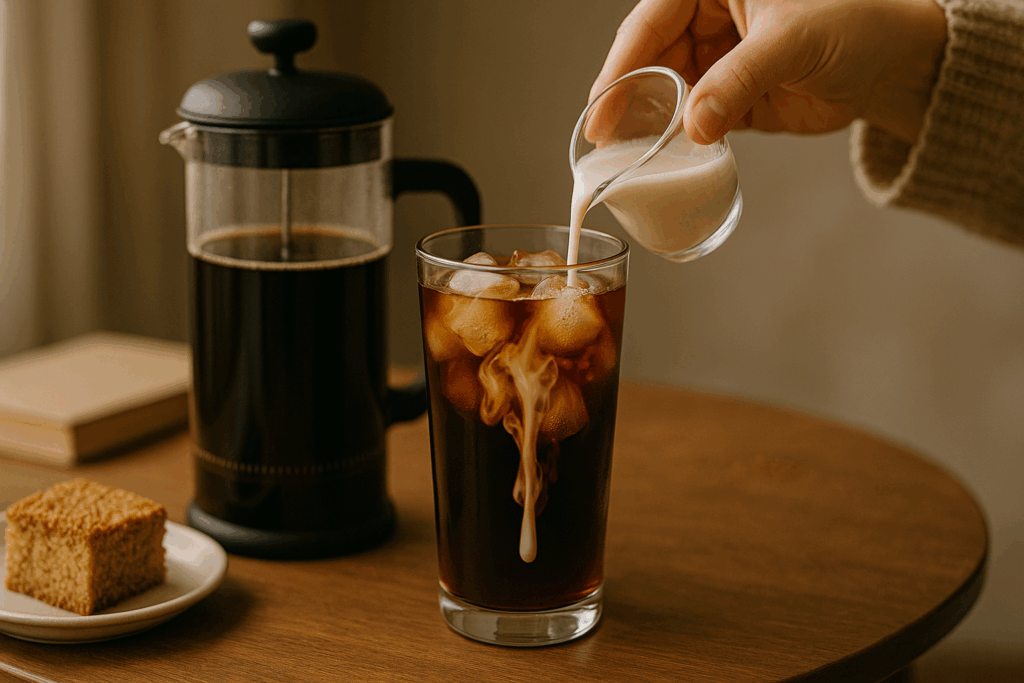
You can enjoy it over ice, on its own, with oat milk or a splash of cream, sweetened with a little maple syrup or vanilla, or even as the base for fun drinks like a cold brew tonic or a lazy afternoon affogato (a simple dessert made by pouring coffee over a scoop of ice cream).
Just give it a gentle shake or stir before pouring, especially if it’s been sitting for a few days—some natural settling is normal.
Why the French Press Is Perfect for Cold Brew
Let’s face it—cold brew gear can get a bit overwhelming. Fancy gadgets, filters, bottles with twist caps… it’s a lot. That’s why the French press is such a smart choice. It’s likely already sitting in your cupboard, and it’s designed for exactly this kind of steep-and-separate brewing. No need for disposable filters or new equipment.
You just mix, wait, press, and pour. The built-in mesh filter handles most of the work, and cleanup is surprisingly easy—especially if you rinse everything out right after brewing. Sure, there might be a few more grounds than with a paper-filter setup, but it’s nothing an extra pass through a paper filter or fine sieve (if you care to) can’t fix. And the payoff? A naturally sweet, smooth, and easy-to-drink coffee that’s hard not to love.
Final Sip: What to Remember
Making cold brew with a French press is one of those low-effort, high-reward habits that quickly becomes part of your routine. You don’t need special tools or barista skills—just a bit of time and a good grind. Whether you like it black, creamy, sweet, or spiced up, French press cold brew is endlessly flexible. So go ahead: mix, wait, and enjoy the chillest way to drink coffee at home.

